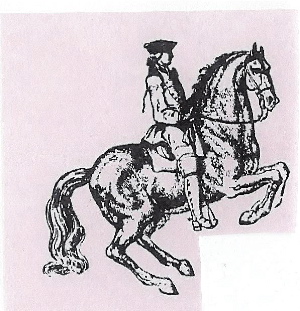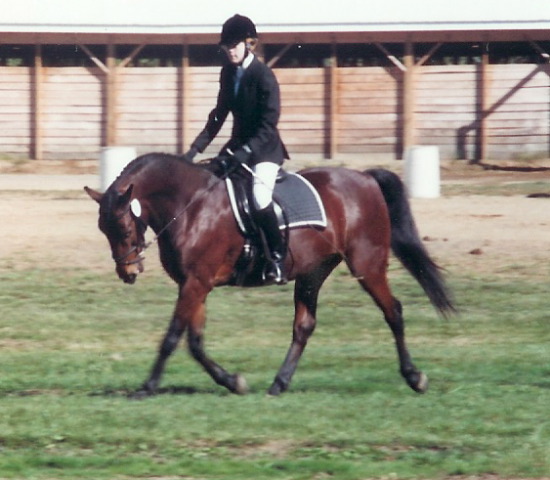|
Vol.: 1 Issue 5: March/April 2004
Equestrian Etiquette
Q: Why do we sweep before we go into the arena?
A: So that the area where you groom is clean for a peson who
may come to groom while you are riding. It is common courtesy and it shows respect to the barn where you board. Also, it is
correct equestrian ettiquette.
Puppy Love
Silliness or not, I always remind people of what dog spells backwards: (GOD!) The
other day, this simple thought came to me...Imagine if when we greeted one another we were so happy like our dogs are when
they see us. I would come to the barn with an enthusiastic "Hi, Kathy, how are you?" I'd be all happy and wag my tail (!!).
Instead, we humans barely recognize one another with a quiet hello and start grooming our horses. I told you it was silly,
but, our dogs are so full of joy and unconditional love. Where does this come from, and how does one acquire this behavior?...If
anyone has the answer let me know!
The Rider's Hands...article to come...

Herbs of the World
Years ago we had someone come to Coventry
and give a lecture on herbs for horses and their general health. Here are some of the highlights from that talk.
Horses are not meant to eat heavy foods
or concentrated foods like sweet feed. Horses are meant to eat grasses – remember they are herbivores. Herbs are grass
foods, thus let your foods be your medicine! Horses who are fed a lot of concentrated feeds get a build-up of lactic acid
in the system and arthritis thrives in an acid condition. The herbalist says that alfalfa neutralizes acid in the system as
it alkalizes the body. A high acid body also sucks the calcium from the bones which also causes arthritis. A good remedy for
arthritis would be alfalfa, yellow dock, dandelion and kelp. A few of the basic herbs she mentioned were bee pollen, black
cohesh for nerves, bone set for its mineral content, lobelia to relax the lungs, elcampane for heaves, kelp to balance the
thyroid, feverfew as a natural bute, aloe for arthritis, arnica for bruises or sore muscles (used externally), chamomile for
nerves and anxiety and chaparral to cleanse the lymph. Of course, this herbalist was quick to mention the 27 side effects
of ivermectin. (Hmmm, anyone want to research this and sent to In Stride?)
 Video Review
Symmetry in Motion is a video by Doris Halstead who wrote the book, Release the Potential.
(Read about Doris in the October In Stride.) This is a great video about realignment of horse and rider using myofascial
release. The beginning of the tape is a little slow with just lecturing, but as it progresses it shows exercises for
both horse and rider. The WPDA owns this tape and Anita, who boarrds Midnight here, is the new WPDA tape librarian. So
call Anita and take a look at this video or any of the many others. It's only $2.00 per rental for WPDA members. Look on the
WPDA web site for a list of tapes (www.wpdadressge.org).
Parents, do you
have children who show?
Here are some tips from Raising
a Good Sport in an In Your Face World by George Selleck, PhD.
-
Don’t
ridicule or yell at your child for making a mistake.Remind your children they’re there to have fun.
-
Improve your listening skills with
your child’s perspective.
-
If you can’t sit in the stands
without making comments, go somewhere you can’t be heard.
-
Applaud good performances by other
competitors
-
Focus on what your children can do,
rather than what they can’t do.
-
Discuss with your children the imiportance
and the “spirit” of rules.
-
Encourage your children to give back
to the community, and to give back to one another by teaching each other new skills.
The Training Scale
(Oh no, do we want to go there??)
How the Training Scale
works…and Why
By Felicitas Von Neumann-Cosel
Practical Horseman Oct 2003
“We talk about the scale of training
– rhythm, relaxation, contact, impulsion, straightness, and collection – as sequential. Until you have rhythm,
you can’t have relaxation; until you have relaxation, you can’t establish contact; until you establish contact,
you can’t produce impulsion; and so on.
This sequence is mirrored in our dressage
tests. At Training Level, all we ask of your horse is that he be relaxed, moving freely forward in clear and steady rhythm,
and accepting contact with the bit. At First Level, we also want him to show that he’s developing pushing power, or
impulsion. At Second Level, he must begin to demonstrate straightness and collection.”

|
 |
|
|
|
 |
 |
 |
|
In Training

I am warming up for a Training
Level Test and asking my horse to stretch.
Wow, this is a really nice picture. It has so many good qualities about it from great
contact on both reins, good leg position, the horse is tracking up, and rider is so neat and clean plus in a perfect position
for stretching the horse. If I were to nit pick, I would say that the rider’s stirrup leather is twisted (I blew the
picture up), her hands could be closer together, and her left shoulder should be positioned just a little bit more to the
left. However, it looks as though this rider is really concentrating and she obviously has not noticed the leather being twisted.
(Show nerves – been there, done that!) Her contact with the hands being a bit too wide, is ok, in my school of thought,
because she is just allowing her reins to stretch and go down. You can tell this horse is ready to go further down at the
rider’s command, but is waiting for her signal. When a rider does stretch a horse there are moments when you have to
widen the hands somewhat to keep the contact. I would rather see this kind of engaged riding with the contact steady and complete,
than the hands together with no contact. This horse is obviously light in the rider’s hands; I see no tension anywhere
in this picture - not in the rider, not in the horse. I rate this overall harmonious team a 9.
Living Your Riding Position
April 1, 2004
WPDA General Meeting with Dr. George Felder
Dr. George Felder has been an equestrian all his life and has intensely studied
dressage and body awareness for many years. His presentation included information about Yoga, the Alexander Technique and
Dressage using quotes from Sally Swift, Bauchet, Barbier and Museler. Riders can't go wrong when combining these authors and
cisciplines into their repertoire of communion with the equine.
George began the lecture with his history of how he started exploring ways to relax.
"Being a type A person led me to explore. It was that or go crazy. I had to learn to slow down and riding was an outlet for
my intense personality, but I discovered that dressage was very humbling. You can be a great looking rider on the horse, but
be totally ineffective. A good riding position equals the most efficient movement from the horse, and a good position has
to be dynamic - it cannot be just good posture." George used the example of a surfer to explain that good posture is not just
standing on the board and assuming the position of a surfer, but rather knowing the moves to ride the waves. Thus, to really
surf or ride, it takes a dynamic position, not just good posturing! The horse is like the waves a surfer has to encounter,
they have to bend the knees and hips to move with each thrust from the water underneath them, just like we have to go with
the horse and not just sit stiff and rigid against the horse's movement. To acquire this dynamic positioning and ability to
feel the horse requires years of dedication to the sport. With a practice of some kind of body awareness techniques such as
Yoga or the Alexander Technique one's journey will be enhanced.
Riding requires all of our five senses and also the 6th sense which George called
kinesthetic awareness. Another way to tune into this awareness type of riding is by practicing such exercises as Sally Swift's
"soft eyes" which allows the rider to become more aware and receptive. As a result, the body goes to a place where it can
relax.
This is the opposite of tunnel vision, or the concept of being too focused and fixed
on one thing. Focusing while learning to ride is a common fault especially during lessons when our trainers are constantly
saying "do this, do that, and do this, do that". Until students actually feel the "this and that" of what they are doing,
they have not learned anything.
Learning to ride is like learning how to play an instrument. First you have to consciously
learn what you are doing, then in time you can eventually play without thinking about it. This is when the ability to play
goes into the subconscious and you play on automatic pilot. This is how it needs to be with riding. The rider needs correct
position, with a dynamic feeling body, and then the ability to just do "this and that" (coordinate the aids) will just happen.
George called this the "cosmic consciousness of riding", or being in the zone.
In books we read that riding should be effortless and when one lets go and rides
with soft eyes and dynamic positioning, it is easier, but with most of us it is an uphill battle trying to overcome our inability
to let go and ride dynamically. Just think of all those years you were told to "sit still", stop fidgeting. These are commands
from both our riding instructors over the years and our parents at the dining room table, but in order to really be able to
ride well we have to learn to allow the correct use of our bodies to take over. The Alexander teachers call this correct use
of "Primary Control". We have such "downward pulls" in our lives from not only gravity but muscles contracting, that it is
very hard to overcome, let alone overcome while riding a horse. Then, of course, over the years we get "habitual positioning"
with our bodies and that really interferes with our attempts to "maximize our ease of movement and maintain a dynamic posture
on the horse".
Dr. Felder believes to be able to go with the horse in a dynamic psoition, we have
to acquire these abilities first off the horse and learn to "Live our Riding Position". We have to practice yoga or another
kind of exercise that stretches, strengthens, coordinates and relaxes our bodies. We must know our bodies, learn how to center,
and be able to experience "the now", or live in the moment...! (Editor's note: Sometimes I think most of us ride just to experience
living in the moment and to be able to let go of our constant thinking about doing.)
At the end of the presentation, Amaera, George's wife, led the audience through a
Yoga exercise. After her brief introduction to Yoga, if we were not already sitting straighter in our chairs and letting go
of our own personal "downward pulls", to make our bodies a little better for riding, then, by golly, we were inspired to get
out there the next day and do something to improve ourselves so it would reflect in our horse's way of going. (To be continued...)
|
 |
|
|
|



